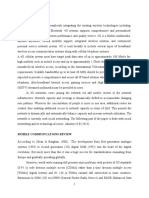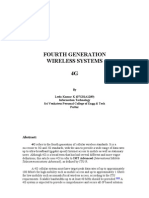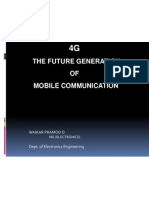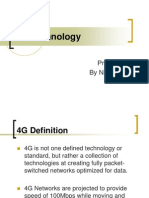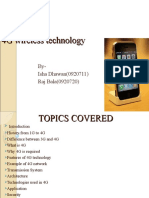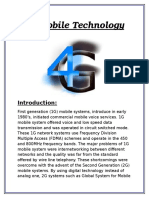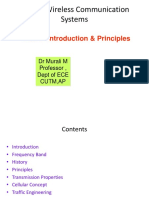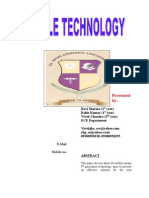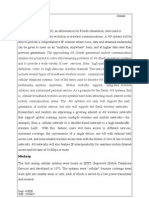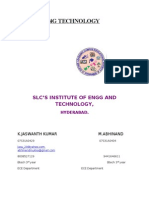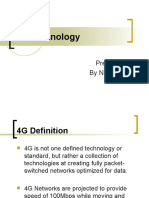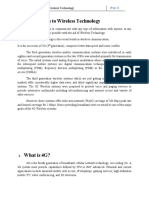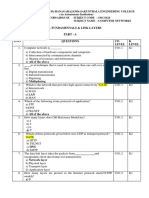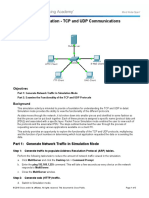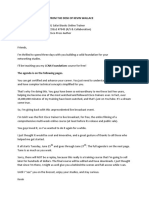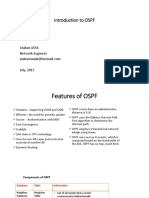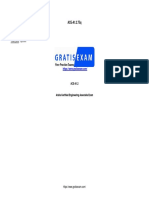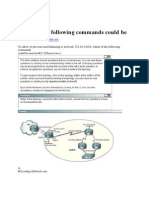Index
1.0 Introduction……………………………………………….02
1.1 1st generation……………………………………………………………………………….03
1.2 2nd generation …………………………………………………………………………..…03
1.3 3rd generation………………………………………………………………………………03
1.4 4th generation………………………………………………………….…………………..04
2.0 Types of multiplexing………………………………….05
3.0 Quality of services………………………………………06
4.0 3G evolution……………………………………..……….07
5.0 TDMA/FDMA………………………………………………08
6.0 CDMA………………………………………………………..09
7.0 OFDM………………………………………………………..10
8.0 SIGNAL ARRIVAL PATH……………………………….11
9.0 4G Services…………………………………………….....12
10.0 3G & 4G parameters…………………………….....13
11.0 Conclusions……………………………………………...16
1
�INTRODUCTION
2
� 1st Generation
Definition:
1G signifies first-generation wireless analog technology standards that
originated in the 1980s. 1G was replaced by 2G wireless digital standards.
Simplest type to wireless data
Average between 4,800 to 9,600 bps (bits per second)
nd
2 Generation
Definition:
2G signifies second-generation wireless digital technology. Fully digital 2G networks
replaced analog 1G which originated in the 1980s. 2G networks saw their first commercial
light of day on the GSM standard. GSM stands for global system for mobile communications.
3rd Generation
Definition:
3G is the third generation of mobile phone standards and technology. 3G network
launched in May 2001 by DoCoMo in Japan.
3G technologies enabled faster data-transmission speeds, greater network capacity
and more advanced network services.
Allows the transmission of 384kbps for mobile systems and up to 2Mbps.
3
� 4th Generation
4G also called as Fourth-Generation Communications System, is a term used to describe the
next step in wireless communications. A 4G system can provide a comprehensive IP solution
where voice, data and streamed multimedia can be provided to users on an "Anytime,
Anywhere" basis. The data transfer rates are also much higher than previous generations
Overview features of 4g technology:
Fourth Generation Technology
Faster and more reliable 100Mbps/ 1 Gbps
Lower cost than previous generations
Multi-standard wireless system –Bluetooth, Wired, Wireless
OFDM used instead of CDMA
The main objectives of 4G are:
4G will be a fully IP-based integrated system.
This will be capable of providing 100 Mbit/s and 1 Gbit/s speeds both indoors and
outdoors.
It can provide premium quality and high security.
4G offer all types of services at an affordable cost.
4
� Types of Multiplexing
FDMA :
Each phone call is allocated one frequency for the entire duration of the call.
TDMA:
Each phone call is allocated a spot in the frequency for a small amount of
time, and "takes turns" being transmitted.
CDMA :
Each phone call is uniquely encoded and transmitted across the entire
spectrum, in a manner known as spread spectrum transmission.
OFDM:
Frequency orthogonality as compared to code orthogonality in CDMA using
Walsh Code
5
� Quality Of Service
4G is developed to provide high quality of service (QoS) and rate requirements set by
forthcoming applications such as wireless broadband access, Multimedia Messaging, Video
Chat, Mobile TV, High definition TV content, minimal service like voice and data, and other
streaming services.
4G technology allow high-quality smooth video transmission. It will enable fast
downloading of full-length songs or music pieces in real time.
Auditing,
Authentication
Authorization
Accounting
Charging
Security
Differentiated Services
Signaling
L2 / L3 mapping
Policing
AAAC
Mobility
Handover
(Seamless, fast)
Mobile IPv6
Paging
6
� 3G Evolution
3G Evolution
2.5G
GPRS 3.5G
GSM EDGE
HSCSD 170 kbps 473 kbps EDGE Ph2
15.2 kbps GRAN
473 kbps
TDMA TD-SCDMA
CDPD TD-SCDMA Ph 2
43.2 kbps 284 kbps 2 Mbps
WCDMA TDD 2 Mbps
PDA/PDC-P WCDMA FDD
14.4 kbps 2 Mbps WCDMA HSDPA 10 Mbps
CDMA2000 1x 1XEV-DO (HDR) 2.4 Mbps
cdmaOne 307 kps
76.8 kbps 1XEV-DV (HDR) 5.4 Mbps
HyperLAN2
54 Mbps Harmonized
WLAN HyperLAN2
IEEE 802.11b And IEEE 802.11a
IEEE 802.11 a/h
11 Mbps
54 Mbps
WiMAX/HyperMAN also in the mix
Ref: Honkasalo et al, WCDMA and WLAN for 3G and Beyond, IEEE Wireless Communication, Apr 2002 17
SRB 041406 ver1
7
� TDMA/FDMA
TDMA/FDMA
slot 1 slot 2 ... Slot n
Frequency 1 Circuit Circuit Circuit
Frequency 2 Circuit Circuit Circuit
.
. Downlink Path
.
Frequency Frequency n Circuit Circuit Circuit
Domain
Frequency 1 Circuit Circuit Circuit
Frequency 2 Circuit Circuit Circuit
.
. Uplink Path
.
Frequency n Circuit Circuit Circuit
Give the same air to all
5
SRB 041406 ver1
8
� CDMA
Channelization code: Separate xmissions
from a single source from each other
Scrambling code: separate different sources
from each other
Spreading Code = Channelization code x
Scrambling code
9
�Orthogonal Frequency Division
Multiplexing (OFDM)
Successor to Frequency Hopping and Direct Sequence CDMA
Capability to cancel multipath distortion in a spectrally efficient manner
without requiring multiple local oscillators (802.11a and 802.16)
Based on use of IFFT and FFT
Frequency orthogonality as compared to code orthogonality in CDMA using
Walsh Code
10
� SIGNAL ARRIVAL PATHS
Multipath Arrival of Signals
Y Y
Transmitted
symbol
received signal Modified with the combined
at each time delay channel estimate symbol
finger #1
finger #2
finger #3
7
SRB 041406 ver1
11
� 4G services
2MHz video telemedicine
conferencing Video on Mobile
demand TV
electronic
Internet radio newspaper
Bandwidth paging
audio
conferencing messaging Mobile
radio
Fax
voice
1KHz
bi-directional unidirectional Broadcast/
multicast
12
� PARAMETRS
Key 3G and 4G Parameters
Attribute 3G 4G
Major Characteristic Predominantly voice- data as Converged data and VoIP
add-on
Network Architecture Wide area Cell based Hybrid – integration of
Wireless Lan (WiFi), Blue
Tooth, Wide Area
Frequency Band 1.6 - 2.5 GHz 2 – 8 GHz
Component Design Optimized antenna; multi- Smart antennas; SW multi-
band adapters band; wideband radios
Bandwidth 5 – 20 MHz 100+ MHz
Data Rate 385 Kbps - 2 Mbps 20 – 100 Mbps
Access WCDMA/CDMA2000 MC-CDMA or OFDM
Forward Error Correction Convolution code 1/2, 1/3; Concatenated Coding
turbo
Switching Circuit/Packet Packet
Mobile top Speed 200 kmph 200 kmph
IP Multiple versions All IP (IPv6.0)
Operational ~2003 ~2010 44
SRB 041406 ver1
13
� TOWARDS 4G NETWORKS
The make before break and bicasting paradigms employed in Moby Dick allow having almost
data loss during FHO, provided that the MN has coverage of both the old and new cells during
The total FHO time. The less time this FHO time lasts, the less the cells will need to overlap. As
explained in Section IV.B, in Moby Dick this FHO time includes the time needed to prepare the
(ST) and the time to do the HO (HL). With the results of Section IV.B, we can estimate that a
time of about 40 ms is needed to perform a complete FHO procedure. To support users
moving a maximum speed of 180 km/h we can deduce that in 4G networks cells will have to
overlap which is negligible. Note that the biggest factor in ST time is context transformation
in QoSB. Several QoSBs can exist within a domain, each controlling an appropriate number of
Access Routers (and thus of Mobile Nodes) and, as a result, presenting no scalability concerns.
Another aspect that requires fast response is the awaking of a MN. It was shown in Section
V.B that this time is about 0,5 s. To avoid any loss in the data sent to the MN being awaked,
the PA must have a 1 kb buffer reserved for each dormant MN, provide the data is sent to the
MNs being awaked at a rate of 2 kbps. As this will be the start of a communication session, it
is not foreseeable that these assumptions are problematic. In fact, the users have not
provided any significant complain when using the system with common applications (such as
web browsing and instant messaging). Criticality for scalability AAAC.h server centralizes all
the AAAC processing for the users of a 4G operator. AAAC aspects dealt by the AAAC.h must
scale. In Moby Dick we decided the AAAC.h to be stateless thus doing very few processing for
each user and thus likely posing few scalability concerns for AAA aspects (only one 1 ms to
authorize a user, as written in section IV.D). During registration, most of the processing is
dealt by the AAA client in the Access Router, including DH key calculation. But since AAA
clients do not centralize all the users (they only handle the users attached to the
corresponding AR) this does not represent a scalability problem. On the other side, charging is
a resource consuming process. Charging should be accomplished in machines different from
the AAA.h server. Users and charging databases will be shared among the charging and the
AAA.h server machines. This same comment applies for the Auditing process. C. Criticality for
efficiency MD provides a common framework for the development of any kind of services to
be provided, by using a common infrastructure. However, in order to guarantee efficiency
(optimal spent of resources) we should take into consideration the upper layers. Two
representative examples can be given: - VoIP application produces an extremely high
overhead, due to the low payload generated (33 bytes) and the headers involved; RTP, UDP,
Mobility, IPv6, and Ethernet account for 102 bytes. We introduced additional delay in
packetization, increasing 4 times the payload (while producing almost unnoticeable delay for
the users). - TCP transport protocol implementation uses by default a segment size tuned so
as to the efficiency is maximized (i.e.: payload TCP + TCP + Mobility + IP = 1500 bytes = MTU
Ethernet). Due to the Moby Dick fast handover implementation, this MTU value should be
14
�reduced to 1460, because of the fact of packet bicasting, which adds an extra IPv6 header in
the Access Routers and thus having the risk to create packets bigger than the MTU. IP sec also
adds significant overhead
15
� CONCLUSIONS
In this paper we present field evaluation results of andIP based architecture for a 4G “True-IP”
network developed under Moby Dick Project. Moby Dick demonstrated the seamless
integration of three disciplines, QoS, AAA and IP Mobility, over a heterogeneous network
infrastructure
focusing on three access technologies. These are: WLAN, Ethernet and TD-CDMA. Moby Dick
considers as well multi-provider scenarios and user mobility by decoupling a user from an
end-system and thus allowing customization via a centrally managed profile. With respect to
the market, Moby Dick architecture supports a seamless integration of various access
technologies next to each other and enables a user to maintain any session while seamlessly
changing his location. So, Moby Dick supports roaming agreements between operators of
different technologies; the field trials were connected through the public IPv6 network
showing
the possibility to extend the system to a world-wide scale. The field tests done provide
indications on critical tradeoffs for future 4G networks. Inexperienced users enjoying
the most popular applications over Moby Dick test bed, prove that 4G networks can be a
commercial reality. As a follow up, IST-Daidalos project [3] will allow users to
access services everywhere and every time with cooperation of different providers in a
framework of rich business models.
16
� REFERENCES
[1] 3GPP Technical Specification TS 23.002, v5.0.0:
Network Architecture (Release 5). October 2000.
[2] S. Blake, D. Black, M. Carlson, E. Davies, Z. Wang,
W. Weiss, “An Architecture for Differentiated
Services”, Internet Engineering Task Force, RFC
2475, December 1998.
[3] Daidalos IST Project. http://www.ist-daidalos.org.
[4] D. Durham, Ed., “The COPS (Common Open Policy
Service) Protocol” RFC 2748, January 2000.
[5] Pascal Kurtansky et al., “Extensions of AAA for
Future IP Networks”, WCNC 2004, Atlanta, USA.
[6] C. d. Laat, et al. Generic AAA Architecture; Internet
Engineering Task Force, RFC 2903, August 2000.
[7] Victor Marques et al., “An IP-based QoS Architecture
for 4G operator scenarios”. IEEE Wireless
Communications. June 2003
[8] Moby Dick IST Project. http://www.ist-mobydick.org.
[9] A. Sarma, et.al.: “Solutions for Ipv6-based mobility in
the EU project Moby Dick”, World Telecom
Congress, Paris, September 2002.
[10]Pablo Serrano et al. “Medida y analisis del trafico
multimedia en redes moviles de cuarta generacion”,
Telecom I+D 2004, Madrid
17






